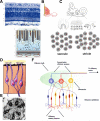Axonemal positioning and orientation in three-dimensional space for primary cilia: what is known, what is assumed, and what needs clarification
- PMID: 22012592
- PMCID: PMC3278774
- DOI: 10.1002/dvdy.22756
Axonemal positioning and orientation in three-dimensional space for primary cilia: what is known, what is assumed, and what needs clarification
Abstract
Two positional characteristics of the ciliary axoneme--its location on the plasma membrane as it emerges from the cell, and its orientation in three-dimensional (3D) space--are known to be critical for optimal function of actively motile cilia (including nodal cilia), as well as for modified cilia associated with special senses. However, these positional characteristics have not been analyzed to any significant extent for primary cilia. This review briefly summarizes the history of knowledge of these two positional characteristics across a wide spectrum of cilia, emphasizing their importance for proper function. Then the review focuses what is known about these same positional characteristics for primary cilia in all major tissue types where they have been reported. The review emphasizes major areas that would be productive for future research for understanding how positioning and 3D orientation of primary cilia may be related to their hypothesized signaling roles within different cellular populations.
Copyright © 2011 Wiley Periodicals, Inc.
Figures











Similar articles
-
How signals of calcium ions initiate the beats of cilia and flagella.Biosystems. 2019 Aug;182:42-51. doi: 10.1016/j.biosystems.2019.103981. Epub 2019 Jun 13. Biosystems. 2019. PMID: 31202860
-
The mechanics of cilia and flagella: What we know and what we need to know.Cytoskeleton (Hoboken). 2024 Nov;81(11):648-668. doi: 10.1002/cm.21879. Epub 2024 May 23. Cytoskeleton (Hoboken). 2024. PMID: 38780123 Review.
-
A function for the Joubert syndrome protein Arl13b in ciliary membrane extension and ciliary length regulation.Dev Biol. 2015 Jan 15;397(2):225-36. doi: 10.1016/j.ydbio.2014.11.009. Epub 2014 Nov 20. Dev Biol. 2015. PMID: 25448689
-
Defects in the cytoplasmic assembly of axonemal dynein arms cause morphological abnormalities and dysmotility in sperm cells leading to male infertility.PLoS Genet. 2021 Feb 26;17(2):e1009306. doi: 10.1371/journal.pgen.1009306. eCollection 2021 Feb. PLoS Genet. 2021. PMID: 33635866 Free PMC article.
-
Towards an atomic model of a beating ciliary axoneme.Curr Opin Struct Biol. 2023 Feb;78:102516. doi: 10.1016/j.sbi.2022.102516. Epub 2022 Dec 29. Curr Opin Struct Biol. 2023. PMID: 36586349 Review.
Cited by
-
The G protein-coupled receptor Gpr161 regulates forelimb formation, limb patterning and skeletal morphogenesis in a primary cilium-dependent manner.Development. 2018 Jan 8;145(1):dev154054. doi: 10.1242/dev.154054. Development. 2018. PMID: 29222391 Free PMC article.
-
Physiological and Pathophysiological Aspects of Primary Cilia-A Literature Review with View on Functional and Structural Relationships in Cartilage.Int J Mol Sci. 2020 Jul 14;21(14):4959. doi: 10.3390/ijms21144959. Int J Mol Sci. 2020. PMID: 32674266 Free PMC article. Review.
-
Linking the Primary Cilium to Cell Migration in Tissue Repair and Brain Development.Bioscience. 2014 Dec 1;64(12):1115-1125. doi: 10.1093/biosci/biu179. Epub 2014 Nov 25. Bioscience. 2014. PMID: 26955067 Free PMC article.
-
The primary cilium is a self-adaptable, integrating nexus for mechanical stimuli and cellular signaling.Biol Open. 2015 Nov 24;4(12):1733-8. doi: 10.1242/bio.014787. Biol Open. 2015. PMID: 26603473 Free PMC article.
-
Situs inversus and ciliary abnormalities: 20 years later, what is the connection?Cilia. 2015 Jan 14;4(1):1. doi: 10.1186/s13630-014-0010-9. eCollection 2015. Cilia. 2015. PMID: 25589952 Free PMC article.
References
-
- Afzelius BA. The immotile-cilia syndrome: a microtubule-associated defect. CRC Crit Rev Biochem. 1985;19:63–87. - PubMed
Publication types
MeSH terms
Grants and funding
LinkOut - more resources
Full Text Sources

